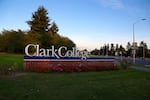Karin Edwards focused on Clark College’s dedication to racial equity work in her first official address this week as president of the Vancouver-based community college. Edwards also gave updates on a challenge facing numerous higher education institutions in 2021: dealing with a looming budget deficit amid the uncertainty of a pandemic.
Edwards stepped into her role as president last year, following a discrimination scandal that centered around the college’s last leader, Bob Knight, and ongoing concerns over equity concerns raised by students, staff and faculty.
Edwards was originally to give her State of the College address back in January, but it was rescheduled due to technical difficulties. Most of Edwards’ remarks Thursday focused on the college’s work to center equity moving forward.

A sign marks the Clark College campus in Vancouver, Washington.
Molly Solomon / OPB
“Why lead with racial equity? Because our data shows clear disparities in how students of color and from other systemically nondominant communities experience Clark,” Edwards stated.
For example, last year, 53% of white students completed introductory English courses, English 100 and 102, in their first year, Edwards said. That compared with only 43% of students of color.
Edwards also said the college sees disparities between 7% and 16% in completion and retention rates between white students and various communities of color.
“What we know from research is that students of color experience additional barriers in the classroom and community because of disenfranchisement, systemic racism, microaggressions and racial aggressions,” Edwards said. “As a result, there is a call to action to do everything we can to close the equity gaps that exist for our historically underserved, including students and employees of color.”
Edwards said the college is using an “equity lens” to review all of its policies and programs including recruitment and hiring, classroom curriculum and student services.
“Equity is woven into everything we do,” Edwards said.
All of that is woven into the college’s Social Equity Plan, Edwards stated. Some of that plan includes the requirement that all employees take one “power, privilege and inequity” training course per year. Clark College last year also introduced a year-long professional development program for employees focused on diversity, equity and inclusion work.
Edwards said the college also received $1 million through the state’s Workforce Investment Act, which she said will go toward priorities including increasing equity training and competency across the college, developing culturally relevant and anti-racist curriculum, and increasing outreach to communities of color.
“It’s important to celebrate progress,” Edwards said. “It’s equally important to remind ourselves we have much work to do to close the equity gaps to increase student success.”
Edwards also acknowledged the pandemic’s disproportionate effects on people of color, as well as the entire community at Clark College.
“In a typical year, many of our students struggle to meet basic needs,” she said. “For far too many of our students, 2020 wasn’t a typical year — it was worse.”
Edwards said the college has worked throughout the pandemic to run its food pantry for students. The college has also loaned hundreds of laptops and wi-fi hotspots to students, she said.
Like with many other public colleges and universities in the northwest, and the nation, Clark College has also been struggling financially during the pandemic.
“We are committed to achieving financial stability at Clark,” Edwards said. “Over the years, as enrollment has declined and expenses have increased, we have experienced ongoing budget deficits which have required reduction in faculty and staff, recalibration and reorganization. … It’s even more challenging now because of COVID-19. We’re in a deficit this current budget year, primarily due to the drop in enrollment.”
Edwards said Clark College has seen a 15% drop in enrollment in the fall and winter terms, and the college is facing a $2.2 million deficit in the current budget year — though, that’s been partially offset by funding from the federal CARES Act last year.
“We are working right now to identify the amount that we will need to cut before the year’s end,” Edwards said.
She said the college is also anticipating further cuts from the Washington legislature.
Edwards said the school plans to close its budget gap at least partially by using $7.7 million in CARES funding, as part of supplemental federal funding just announced in January.
“Early guidance suggests that we will be able to use part of these funds to offset revenue shortfalls, as well as cover increased costs associated with our COVID-19 response,” she said.
The college also plans to use savings from under-spending in its current budget, but Edwards said that will not completely close the long-term gap of rising costs and a decrease in revenue.
“I want to be optimistic, but I also need to be realistic,” she said. “We anticipate cuts at the state level, and those cuts will impact our ability to serve students. We believe revenue will increase as enrollment improves, but it will take time.”
